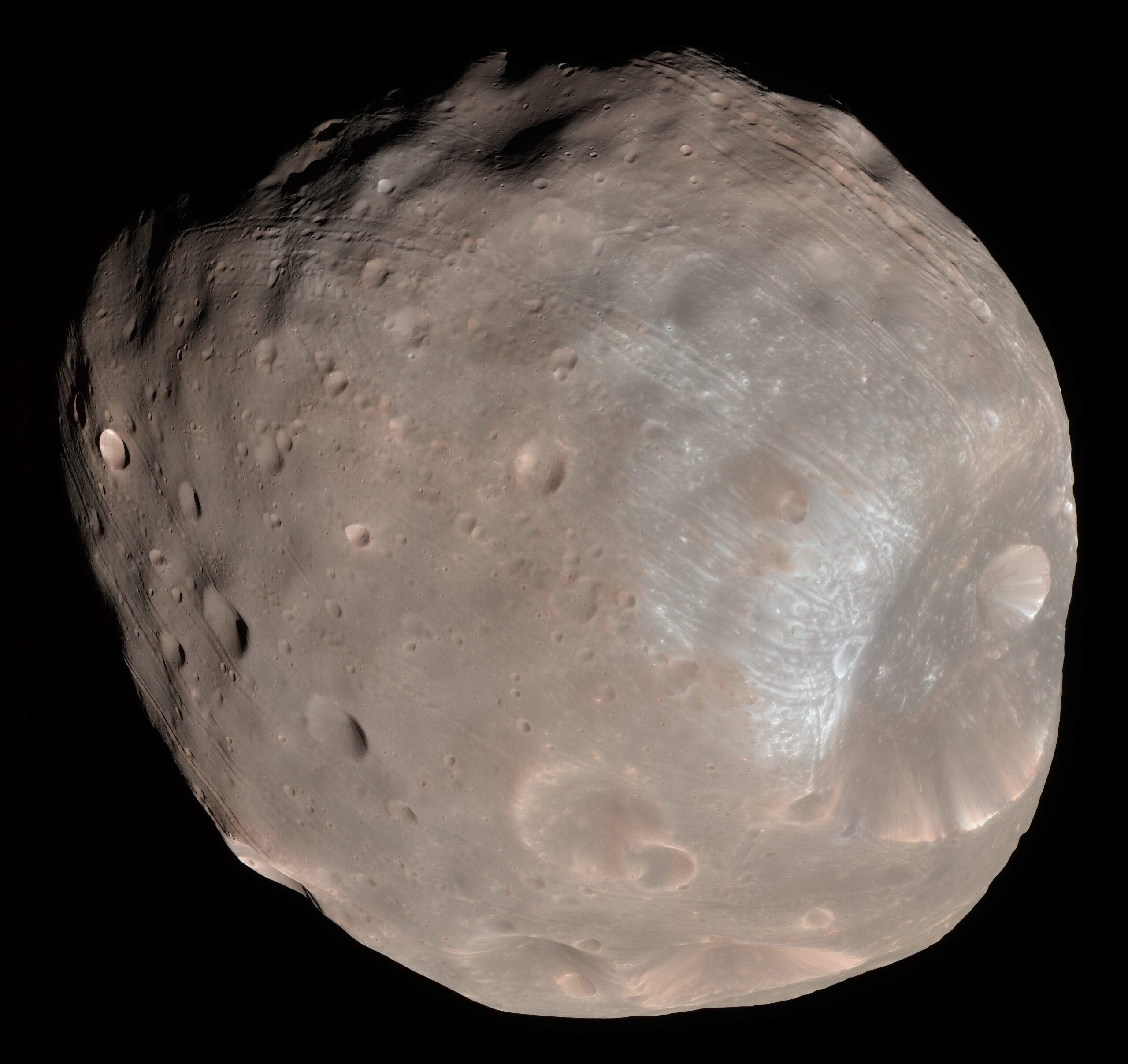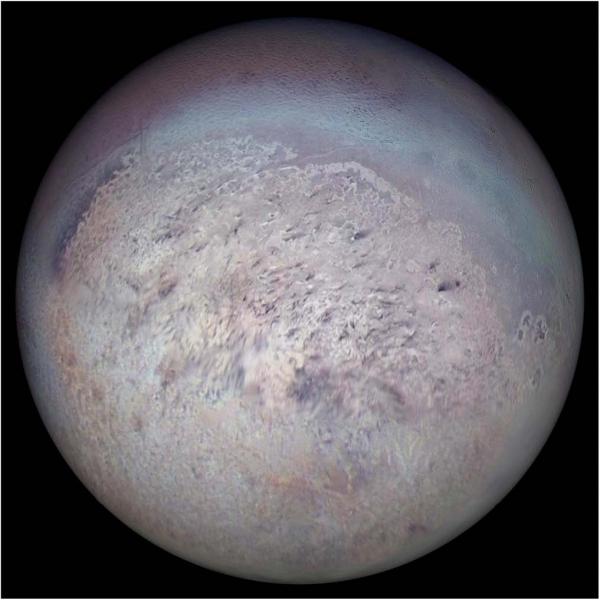*This post may contain affiliate links. This means we may make a commission if you purchase an item using one of our links*
The main differences between Phobos and Triton are that Phobos is much smaller with a diameter of 22.53km compared to Triton’s 2,706km, Triton is spherical in shape while Phobos is not and Triton is one of many planets that orbit Neptune while Phobos is one of 2 that orbit Mars.
There are various other differences between these two celestial objects so, continue reading for a more thorough look at both of them along with a breakdown of their similarities and differences.
What Is The Moon Phobos?
Table of Contents

Phobos is the larger and innermost of the Martian moons, named after the Greek God of fear and panic. This rocky satellite measures approximately 27 x 22 x 18 kilometers and possesses an irregular shape.
Flying only 270 km above Mars’s surface, Phobos orbits the Martian surface so closely that it spins around the planet three times a day (each orbit takes 7 hours and 39 minutes). And this proximity means that the moon cannot always be seen from Mars’ surface (it all depends on where you’re standing).
In general, Phobos rises in the west, passes through the sky in around 4 hours, and sets in the east. And this process occurs twice during one Martian day.
Phobos travels 1.8 m closer to Mars every 100 years, which means this doomed moon will one day crash into its planet or break up into rings. Still, this won’t happen for another 50 million years or so.
The moon is covered in streak patterns from impact craters, the most significant of which is the crater Stickney, with a diameter of 9.7 km. Phobos has weathered thousands of meteorite impacts, one of which almost shattered it to pieces.
It was first discovered by the American astronomer Asaph Hall on 17th August 1877. But, it can be difficult for astronomers to see as it is one of the least reflective bodies in the solar system with an albedo of 0.071.
Despite its small stature, Phobos experiences wildly varying temperatures on its dark side compared to the light side. Measurements on the light side of the moon suggest that temperatures can rise to -4 degrees Celsius, a sort of brisk winter’s day that would be cold but tolerable.
In contrast, temperatures on the dark side can drop to -112 degrees Celsius, even though the two areas are just a few kilometers apart. The probable cause is fine surface dust that cannot retain heat, allowing temperatures to drop rapidly.
The low density of Phobos suggests its composition is similar to carbonaceous chondrite meteorites, which could mean that Phobos is a captured asteroid.
What Is The Moon Triton?

Triton is the largest moon of Neptune, whose most unusual feature is its retrograde orbit. Triton is the only major moon in our solar system which orbits in the opposite direction of its planet’s rotation.
First discovered on 10th October 1846 (just 17 days after the discovery of its planet, Neptune) by British astronomer William Lassell, “Triton” comes from a merman in Greek myth; a name which perhaps stems from the composition of this faraway moon.
The diameter of Triton is approximately 2,706km, making it a similar size to Earth’s moon. However, we know that its mass is far less than the first estimates suggested because data from Voyager showed that the surface is icy and highly reflective, a less dense composition than the dark surface of our moon.
This icy surface has resulted in ice based natural satellite displaying temperatures in the region of – 235 degrees Celsius.
This lower density stems predominantly from the water-ice interior encasing a denser rock core. Still, the mean density of 2.06 grams per cubic cm remains higher than that of any of Saturn’s or Uranus’ moons. In addition, Triton holds more than 99.5% of the mass of everything that orbits the planet Neptune and its total mass is greater than every smaller satellite in the solar system combined.
Scientists think that Triton may be an object from the Kuiper Belt that Neptune’s gravity captured millions of years ago. This is because it shares many similarities with the dwarf planet Pluto – the best-known world within the Kuiper Belt.
This frozen world is a land of geological oddities with craters and a collection of depressions and ridges known as cantaloupe terrain. The geysers found on this moon shoot plumes of nitrogen as high as 8km high, which creates a thin atmosphere of nitrogen.
In around 3.5 billion years, Triton’s orbit will travel too close to Neptune, and the planet’s gravitational pull will break the moon apart, creating a ring system.
Similarities Between Phobos And Triton
As both are natural satellites, Phobos and Triton do share a few similarities, which includes the following:
- Both have a rocky, terrestrial surface.
- Neither have rings surrounding them.
- Both are tidally locked to their planet.
- Both orbit their planet in an elliptical pattern.
- Neither have tectonic plates.
- Neither have a magnetic field.
- Triton and Phobos have a practically non-existent axial tilt.
Differences Between Phobos And Triton
As for the differences between the two, they include the below:
- Phobos orbits Mars whilst Triton orbits Neptune.
- Triton is a spherical shape while Phobos is not.
- Triton has a diameter of 2,706km whilst Phobos has a diameter of 22.53km.
- Phobos has no atmosphere whilst Triton has a thin exosphere composed mostly of nitrogen with small amounts of methane.
- A day on Phobos takes 7 hours 39 minutes whilst a Triton day is 5.877 days.
- It takes Phobos 7 hours 39 minutes to orbit Mars and around the Sun in 687 days whilst Triton orbits Neptune in in 5.877 days and the Sun in 165 years.
- Phobos’ temperature ranges between -4 to -112 degrees Celsius whilst Triton’s is around – 235 degrees Celsius.
- Triton orbits Neptune at an average distance of 354,800km whilst Phobos is 6,000km away from Mars.
- Triton’s density is 2.06 g/cm³ whilst Phobo’s density is 1.88 g/cm³.
- Triton’s mass is 2.14 × 10^22 kg whilst Phobos’ mass is 10.6 × 10^15 kg.
- Phobos’ gravitational strength is 0.0057 m/s² whilst Triton’s is 0.779 m/s².
- Phobos only orbits Mars 6,000km away and is getting closer to the planet by 1.8 meters every 100 years.
- Triton has volcanic activity while Phobos does not.
Summary
Both Phobos and Triton are natural satellites, are tidally locked to their respective planets and are rock based however, they are still unique when you breakdown their features.
Whether it be in regards to their mass, size, physical shape, gravitational strength, how they orbit their respective planets and more, Triton and Phobos are still very distinct celestial bodies in their own right.

